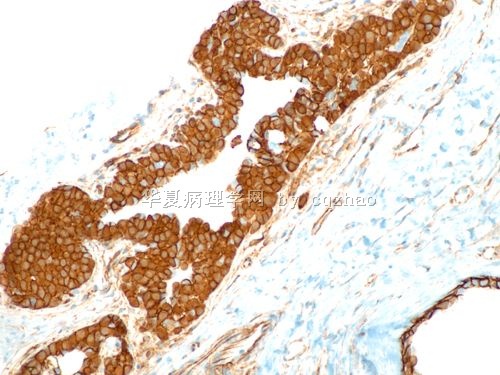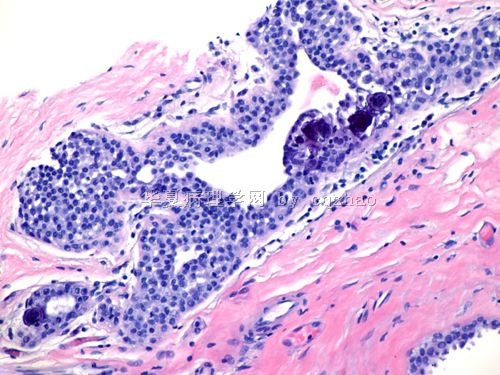| 图片: | |
|---|---|
| 名称: | |
| 描述: | |
- B2945Clinical and biological significance of E-cadherin protein expression in invasive lobular carcinom..
| 姓 名: | ××× | 性别: | 年龄: | ||
| 标本名称: | |||||
| 简要病史: | |||||
| 肉眼检查: | |||||
Am J Surg Pathol. 2010 Oct;34(10):1472-9.
Clinical and biological significance of E-cadherin protein expression in invasive lobular carcinoma of the breast.
Rakha EA, Patel A, Powe DG, Benhasouna A, Green AR, Lambros MB, Reis-Filho JS, Ellis IO.
Department of Histopathology, Nottingham University Hospitals NHS Trust, UK. emadrakha@yahoo.com
Abstract
BACKGROUND: Although virtually all cases of lobular carcinoma in situ lack E-cadherin expression, a proportion of morphologically typical invasive lobular carcinomas (ILCs) retain its expression. The frequency and significance of E-cadherin expression in ILC remain to be elucidated. In this study, we have assessed E-cadherin protein expression in a well-characterized series of histologically defined ILC (239 cases) with a long-term clinical follow-up to determine the frequency, clinical and biological significance of its expression. E-cadherin-positive ILCs (ILC+) were subsequently examined to assess the expression of component members of the E-cadherin membrane complex (E-cadherin, p120, α, β, and γ-catenins) to determine its integrity.
RESULTS: Thirty-eight ILC cases (16%) showed positive E-cadherin expression (ILC+). Membranous expression of E-cadherin was mainly circumferential with frequent coexisting perimembranous cytoplasmic expression. No association between E-cadherin expression and any of the clinicopathologic variables, immunophenotype, or tumor behavior was identified, apart from an association with lobular histologic subtype and vascular invasion. Analysis of the E-cadherin-catenin complex showed abnormal expression of one or more of the catenin complex members in the majority of cases. The most frequent observation was the diffuse cytoplasmic expression of catenins, in particular p120, which showed similar expression to that reported in E-cadherin-negative ILCs.
CONCLUSIONS: These results provide evidence that E-cadherin is expressed in a proportion of ILC, however, unlike ductal carcinoma, its expression seems to be of limited significance and it is usually associated with evidence of impaired integrity of the E-cadherin-catenin membrane complex. Our data offer a possible explanation for the presence but lack functionality of E-cadherin in some cases of ILC and imply that immunohistochemical expression of E-cadherin per se in ILC histologic phenotypic tumors should not preclude its diagnosis.
PMID: 20871222 [PubMed - indexed for MEDLINE]
-
本帖最后由 于 2010-11-28 08:16:00 编辑
相关帖子
-
本帖最后由 于 2010-11-28 17:38:00 编辑
E-cadherin Function
-
本帖最后由 于 2010-11-28 07:03:00 编辑
-
本帖最后由 于 2010-11-11 04:18:00 编辑
It is debatable for dx of invasive lobular ca. It should be based on morphology or IHC. This is an interesting paper. Our breast fellow Dr. James Kraus showed it in our weekly morning fellow journal club.
I paste his powerpoint here for some ones who are interested.

















